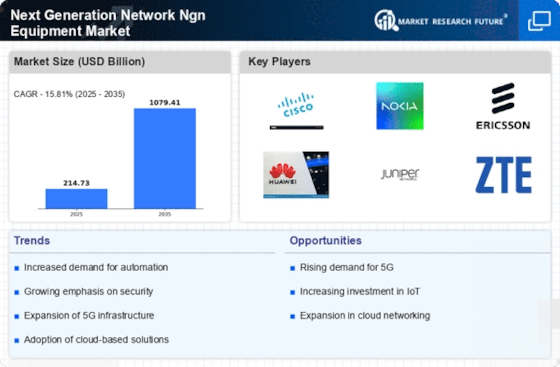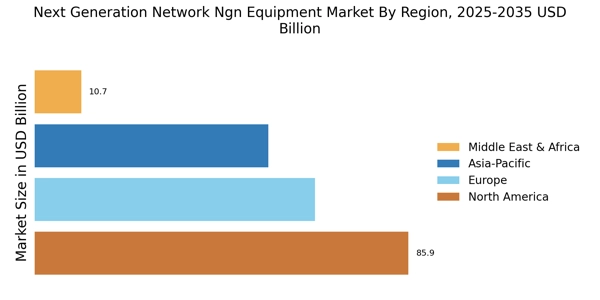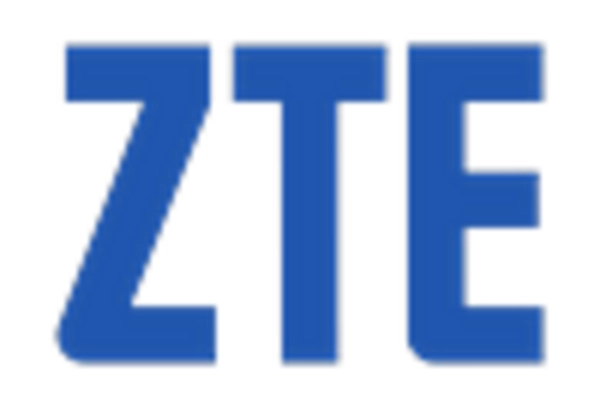Adoption of 5G Technology
The rollout of 5G technology is significantly influencing the Next Generation Network Ngn Equipment Market. With its promise of ultra-fast data speeds and enhanced connectivity, 5G is expected to revolutionize various sectors, including healthcare, automotive, and entertainment. The global 5G infrastructure market is projected to grow substantially, with investments reaching approximately 700 billion by 2026. This transition necessitates the deployment of advanced Ngn equipment capable of supporting the unique requirements of 5G networks, such as massive MIMO and network slicing. As telecommunications companies strive to meet the demands of 5G, the Next Generation Network Ngn Equipment Market is poised for substantial growth, driven by the need for innovative solutions that can handle increased data traffic and provide improved user experiences.
Emergence of IoT Applications
The proliferation of Internet of Things (IoT) applications is a significant driver for the Next Generation Network Ngn Equipment Market. As more devices become interconnected, the demand for reliable and scalable network solutions is intensifying. The number of connected IoT devices is projected to surpass 30 billion by 2026, creating a substantial need for advanced Ngn equipment that can support the increased data traffic and connectivity requirements. This trend is particularly evident in sectors such as smart cities, healthcare, and industrial automation, where IoT applications are transforming operations and enhancing efficiency. As organizations invest in IoT infrastructure, the Next Generation Network Ngn Equipment Market is likely to experience robust growth, driven by the need for equipment that can facilitate seamless communication between devices.
Increased Focus on Network Security
As cyber threats become more sophisticated, the emphasis on network security is driving the Next Generation Network Ngn Equipment Market. Organizations are increasingly aware of the vulnerabilities associated with traditional network architectures, prompting a shift towards more secure and resilient solutions. The Next Generation Network Ngn Equipment is expected to exceed 300 billion by 2026, indicating a strong investment trend in security technologies. This growing focus on security compels network equipment manufacturers to integrate advanced security features into their Ngn solutions, such as encryption, intrusion detection, and threat intelligence. Consequently, the demand for secure Ngn equipment is likely to rise, as businesses seek to protect their data and maintain compliance with regulatory standards, thereby fueling growth in the Next Generation Network Ngn Equipment Market.
Shift Towards Cloud-Based Solutions
The transition towards cloud-based solutions is reshaping the landscape of the Next Generation Network Ngn Equipment Market. As businesses increasingly adopt cloud computing for its scalability and cost-effectiveness, the demand for network equipment that can support cloud services is growing. The cloud services market is anticipated to reach over 800 billion by 2026, highlighting the significant investment in cloud infrastructure. This shift necessitates the deployment of advanced Ngn equipment capable of ensuring reliable connectivity and performance for cloud applications. Furthermore, as organizations migrate their operations to the cloud, the need for enhanced network management and optimization tools becomes critical. Thus, the shift towards cloud-based solutions is likely to drive innovation and growth within the Next Generation Network Ngn Equipment Market.
Rising Demand for High-Speed Connectivity
The increasing demand for high-speed internet connectivity is a primary driver for the Next Generation Network Ngn Equipment Market. As consumers and businesses alike seek faster and more reliable internet services, telecommunications providers are compelled to upgrade their infrastructure. This trend is evidenced by the projected growth in broadband subscriptions, which is expected to reach over 1.5 billion by 2026. Consequently, the need for advanced Ngn equipment that can support higher bandwidth and lower latency is becoming more pronounced. The shift towards remote work and digital services further amplifies this demand, as organizations require robust network solutions to facilitate seamless communication and data transfer. Thus, the rising demand for high-speed connectivity is likely to propel investments in the Next Generation Network Ngn Equipment Market.


















Leave a Comment